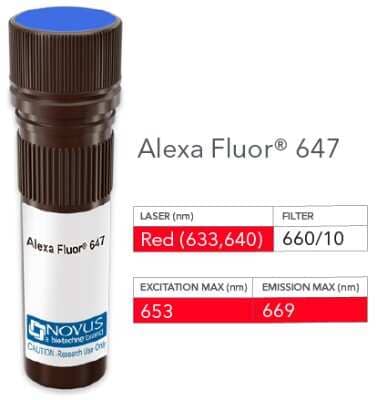B7-2/CD86 Antibody (BU63) [Alexa Fluor® 647]
Novus Biologicals, part of Bio-Techne | Catalog # NBP2-34569AF647


Key Product Details
Species Reactivity
Applications
Label
Antibody Source
Concentration
Product Specifications
Immunogen
Localization
Marker
Clonality
Host
Isotype
Scientific Data Images for B7-2/CD86 Antibody (BU63) [Alexa Fluor® 647]
Applications for B7-2/CD86 Antibody (BU63) [Alexa Fluor® 647]
CyTOF-ready
Flow Cytometry
Immunocytochemistry/ Immunofluorescence
Immunohistochemistry
Immunohistochemistry-Frozen
Immunohistochemistry-Paraffin
Knockout Validated
Western Blot
Reviewed Applications
Read 1 review rated 1 using NBP2-34569AF647 in the following applications:
Formulation, Preparation, and Storage
Purification
Formulation
Preservative
Concentration
Shipping
Stability & Storage
Background: B7-2/CD86
References
1. Collins M, Ling V, Carreno BM. The B7 family of immune-regulatory ligands. Genome Biol. 2005;6(6):223. https://doi.org/10.1186/gb-2005-6-6-223
2. Greaves P, Gribben JG. The role of B7 family molecules in hematologic malignancy. Blood. 2013;121(5):734-744. https://doi.org/10.1182/blood-2012-10-385591
3. Bolandi N, Derakhshani A, Hemmat N, et al. The Positive and Negative Immunoregulatory Role of B7 Family: Promising Novel Targets in Gastric Cancer Treatment. Int J Mol Sci. 2021;22(19):10719. https://doi.org/10.3390/ijms221910719
4. Uniprot (P42081)
5. Bhatia S, Edidin M, Almo SC, Nathenson SG. B7-1 and B7-2: similar costimulatory ligands with different biochemical, oligomeric and signaling properties. Immunol Lett. 2006;104(1-2):70-75. https://doi.org/10.1016/j.imlet.2005.11.019
6. Ohue Y, Nishikawa H. Regulatory T (Treg) cells in cancer: Can Treg cells be a new therapeutic target?. Cancer Sci. 2019;110(7):2080-2089. https://doi.org/10.1111/cas.14069
7. Chen L, Flies DB. Molecular mechanisms of T cell co-stimulation and co-inhibition [published correction appears in Nat Rev Immunol. 2013 Jul;13(7):542]. Nat Rev Immunol. 2013;13(4):227-242. https://doi.org/1010.1038/nri3405
8. Karimi A, Alilou S, Mirzaei HR. Adverse Events Following Administration of Anti-CTLA4 Antibody Ipilimumab. Front Oncol. 2021;11:624780. https://doi.org/101010.3389/fonc.2021.624780
Alternate Names
Gene Symbol
Additional B7-2/CD86 Products
Product Documents for B7-2/CD86 Antibody (BU63) [Alexa Fluor® 647]
Product Specific Notices for B7-2/CD86 Antibody (BU63) [Alexa Fluor® 647]
Alexa Fluor (R) products are provided under an intellectual property license from Life Technologies Corporation. The purchase of this product conveys to the buyer the non-transferable right to use the purchased product and components of the product only in research conducted by the buyer (whether the buyer is an academic or for-profit entity). The sale of this product is expressly conditioned on the buyer not using the product or its components, or any materials made using the product or its components, in any activity to generate revenue, which may include, but is not limited to use of the product or its components: (i) in manufacturing; (ii) to provide a service, information, or data in return for payment; (iii) for therapeutic, diagnostic or prophylactic purposes; or (iv) for resale, regardless of whether they are resold for use in research. For information on purchasing a license to this product for purposes other than as described above, contact Life Technologies Corporation, 5791 Van Allen Way, Carlsbad, CA 92008 USA or outlicensing@lifetech.com. This conjugate is made on demand. Actual recovery may vary from the stated volume of this product. The volume will be greater than or equal to the unit size stated on the datasheet.
This product is for research use only and is not approved for use in humans or in clinical diagnosis. Primary Antibodies are guaranteed for 1 year from date of receipt.